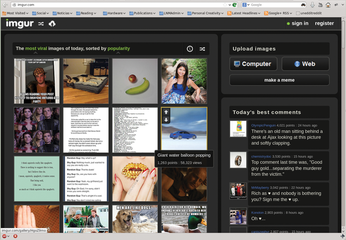Anonymous media sharing with MediaCrush
Up to Speed

Sharing videos or images doesn't always require a full-fledged YouTube or Flickr clone. Sometimes all you want is a quick place to upload, so you can link to your media or share it online. MediaCrush gives you just that, as well as other interesting perks.
MediaCrush [1] is not a Flickr, YouTube, or SoundCloud stand-in, nor is it meant to be. If that's what you need, check out MediaGoblin, which I talked about in a previous article [2]. MediaCrush works more like Imgur [3], which allows you to upload images quickly and easily – with no registration required (Figure 1).

Like Imgur, MediaCrush (Figure 2) does not require registration, and it is absurdly simple to upload images to the site. The main aim of the site is to provide links or code snippets for embedding your media elsewhere. It was originally developed specifically for Reddit and is 100% RES (Reddit Enhanced Suite) compatible [4].
[...]
Buy this article as PDF
(incl. VAT)
Buy Linux Magazine
Subscribe to our Linux Newsletters
Find Linux and Open Source Jobs
Subscribe to our ADMIN Newsletters
Support Our Work
Linux Magazine content is made possible with support from readers like you. Please consider contributing when you’ve found an article to be beneficial.

News
-
Fedora 43 Has Finally Landed
The Fedora Linux developers have announced their latest release, Fedora 43.
-
KDE Unleashes Plasma 6.5
The Plasma 6.5 desktop environment is now available with new features, improvements, and the usual bug fixes.
-
Xubuntu Site Possibly Hacked
It appears that the Xubuntu site was hacked and briefly served up a malicious ZIP file from its download page.
-
LMDE 7 Now Available
Linux Mint Debian Edition, version 7, has been officially released and is based on upstream Debian.
-
Linux Kernel 6.16 Reaches EOL
Linux kernel 6.16 has reached its end of life, which means you'll need to upgrade to the next stable release, Linux kernel 6.17.
-
Amazon Ditches Android for a Linux-Based OS
Amazon has migrated from Android to the Linux-based Vega OS for its Fire TV.
-
Cairo Dock 3.6 Now Available for More Compositors
If you're a fan of third-party desktop docks, then the latest release of Cairo Dock with Wayland support is for you.
-
System76 Unleashes Pop!_OS 24.04 Beta
System76's first beta of Pop!_OS 24.04 is an impressive feat.
-
Linux Kernel 6.17 is Available
Linus Torvalds has announced that the latest kernel has been released with plenty of core improvements and even more hardware support.
-
Kali Linux 2025.3 Released with New Hacking Tools
If you're a Kali Linux fan, you'll be glad to know that the third release of this famous pen-testing distribution is now available with updates for key components.

